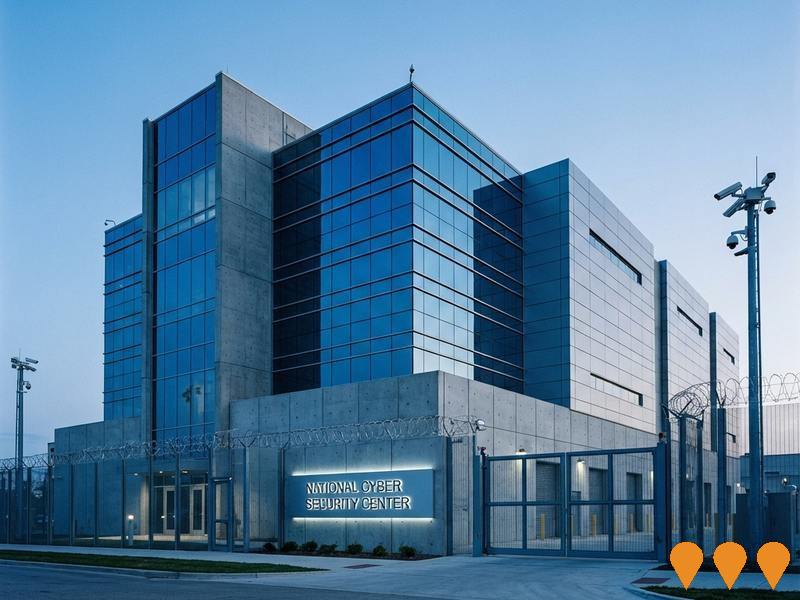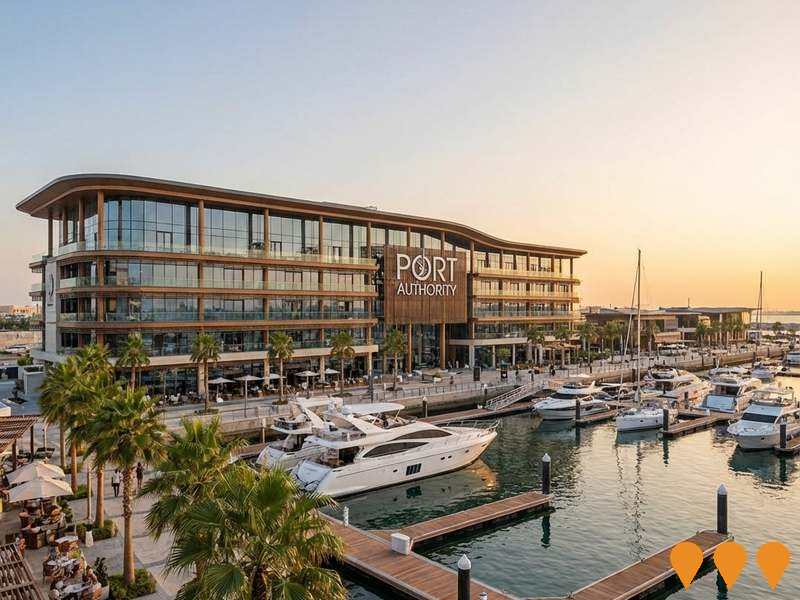Chart Color Schemes
est. as @ -- *
ABS ERP | -- people | --
2021 Census | -- people
Sales Activity
Curious about local property values? Filter the chart to assess the volume and appreciation (including resales) trends and regional comparisons, or scroll to the map below view this information at an individual property level.
Find a Recent Sale
Sales Detail
Population
Outback has shown very soft population growth performance across periods assessed by AreaSearch
Based on AreaSearch's analysis, Outback's population is around 2,000 as of Aug 2025. This reflects a decrease of 30 people since the 2021 Census, which reported a population of 2,030 people. The change is inferred from the estimated resident population of 1,978 from the ABS as of June 2024 and an additional 31 validated new addresses since the Census date. This level of population equates to a density ratio of 0.00 persons per square kilometer. Population growth for the area was primarily driven by overseas migration that contributed approximately 62.5% of overall population gains during recent periods.
AreaSearch is adopting ABS/Geoscience Australia projections for each SA2 area, as released in 2024 with 2022 as the base year. For any SA2 areas not covered by this data, and for years post-2032, the SA State Government's Regional/LGA projections by age category, released in 2023 based on 2021 data, are adopted with adjustments made employing a method of weighted aggregation of population growth from LGA to SA2 levels. Moving forward with demographic trends, projections indicate a decline in overall population, with the area's population expected to shrink by 25 persons by 2041 according to this methodology. However, growth across specific age cohorts is anticipated, led by the 75 to 84 age group, which is projected to increase by 66 people.
Frequently Asked Questions - Population
Development
The level of residential development activity in Outback is very low in comparison to the average area assessed nationally by AreaSearch
Outback has seen minimal construction activity with one new dwelling approved annually over the past five years, totalling eight approvals. This low level of development is characteristic of rural areas where housing needs are modest and construction activity is limited by local demand and infrastructure capacity. It should be noted that with such low approval numbers, yearly growth figures can vary considerably based on individual projects.
Compared to Rest of SA and national patterns, Outback has much lower development activity. All approved constructions in the area have been detached houses, aligning with rural living preferences for space and privacy. The estimated population per dwelling approval is 1974 people, reflecting its quiet, low activity development environment. With stable or declining population projections, Outback should see reduced housing demand pressures, benefiting potential buyers.
With population projections showing stability or decline, Outback should see reduced housing demand pressures, benefiting potential buyers.
Frequently Asked Questions - Development
Infrastructure
Outback has strong levels of nearby infrastructure activity, ranking in the top 40% nationally
Area infrastructure significantly impacts local performance. AreaSearch identified 116 potential impact projects. Key initiatives include Olympic Dam Underground Growth Projects, Olympic Dam Smelter Refinery Expansion Project, Oak Dam Underground Access Project, and Roxby Downs Area School Refurbishment. Below is a list detailing those likely most relevant.
Professional plan users can use the search below to filter and access additional projects.
INFRASTRUCTURE SEARCH
 Denotes AI-based impression for illustrative purposes only, not to be taken as definitive under any circumstances. Please follow links and conduct other investigations from the project's source for actual imagery. Developers and project owners wishing us to use original imagery please Contact Us and we will do so.
Denotes AI-based impression for illustrative purposes only, not to be taken as definitive under any circumstances. Please follow links and conduct other investigations from the project's source for actual imagery. Developers and project owners wishing us to use original imagery please Contact Us and we will do so.
Frequently Asked Questions - Infrastructure
Olympic Dam Smelter Refinery Expansion Project
Proposed expansion of the existing smelter and refinery at Olympic Dam to increase copper cathode production capacity from the current ~200,000 tpa to a potential 650,000 tpa of copper plus associated products (gold, silver, uranium, and acid). This includes a phased strategy involving two-stage smelting with a new primary Flash Smelting Furnace, conversion of the existing Direct Blast Furnace, a new electro-refinery, and supporting infrastructure like water supply linkages (Northern Water Project) and electricity transmission upgrades. A final investment decision is expected in the first half of FY27 (mid-2026 to end-2026). The project is an 'impact assessed development' under assessment by the SA Government and is separate from a concurrent A$840M investment in underground mining and processing improvements.
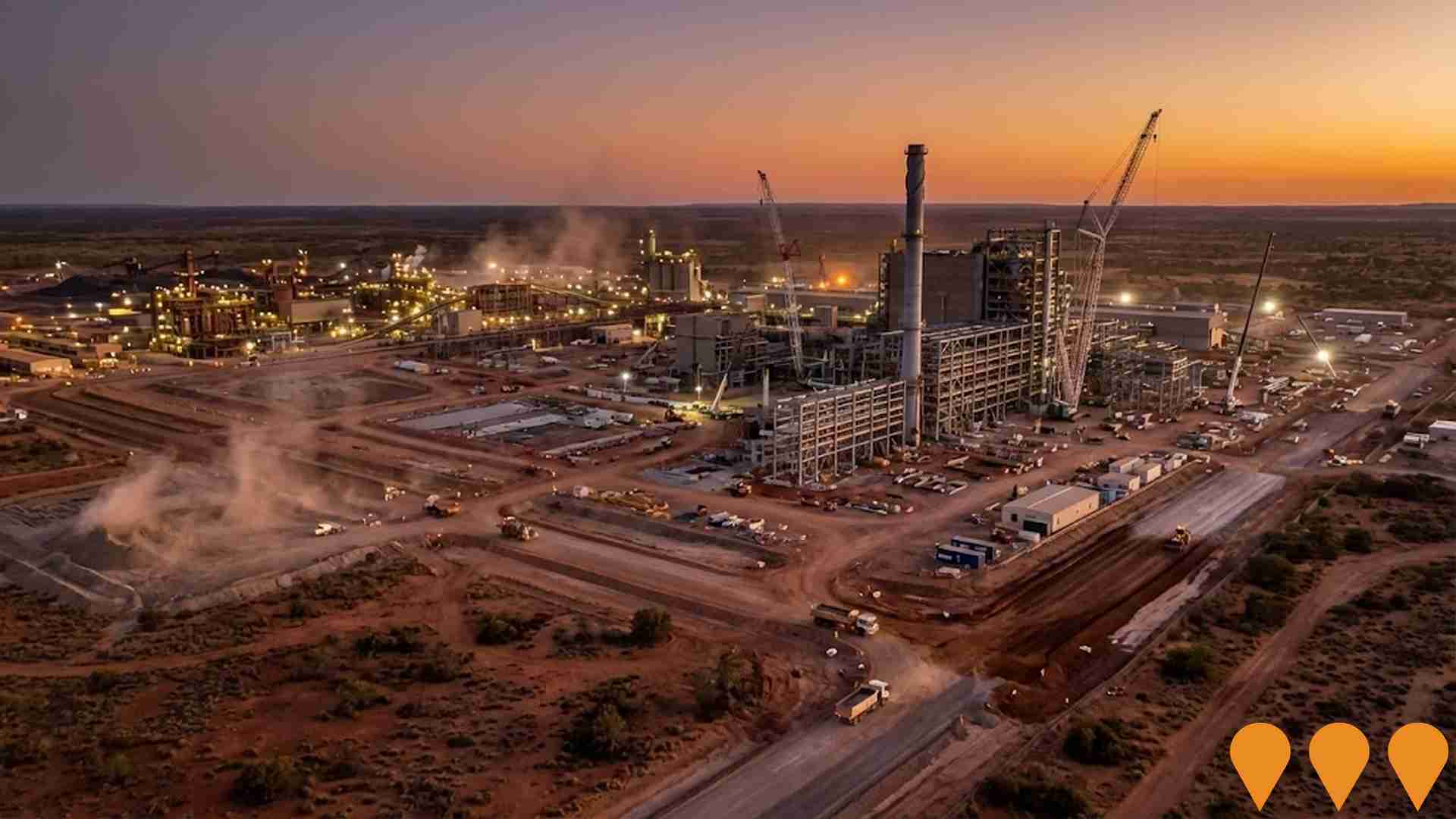
Olympic Dam Underground Growth Projects
A series of growth-enabling underground mining and processing projects with an A$840 million investment. Key elements include: a new underground access tunnel (decline) into the Southern Mine Area; a new backfill system using underground pipes for mine stabilisation; expansion of ore pass capacity with new locomotives and an extended electric rail network; and installation of a new oxygen plant to support smelter debottlenecking, aiming to increase copper concentrate smelting rates from 80 to 85 tonnes per hour. The projects are designed to strengthen underground mining productivity and lay foundations for future growth, creating around 200 construction jobs.
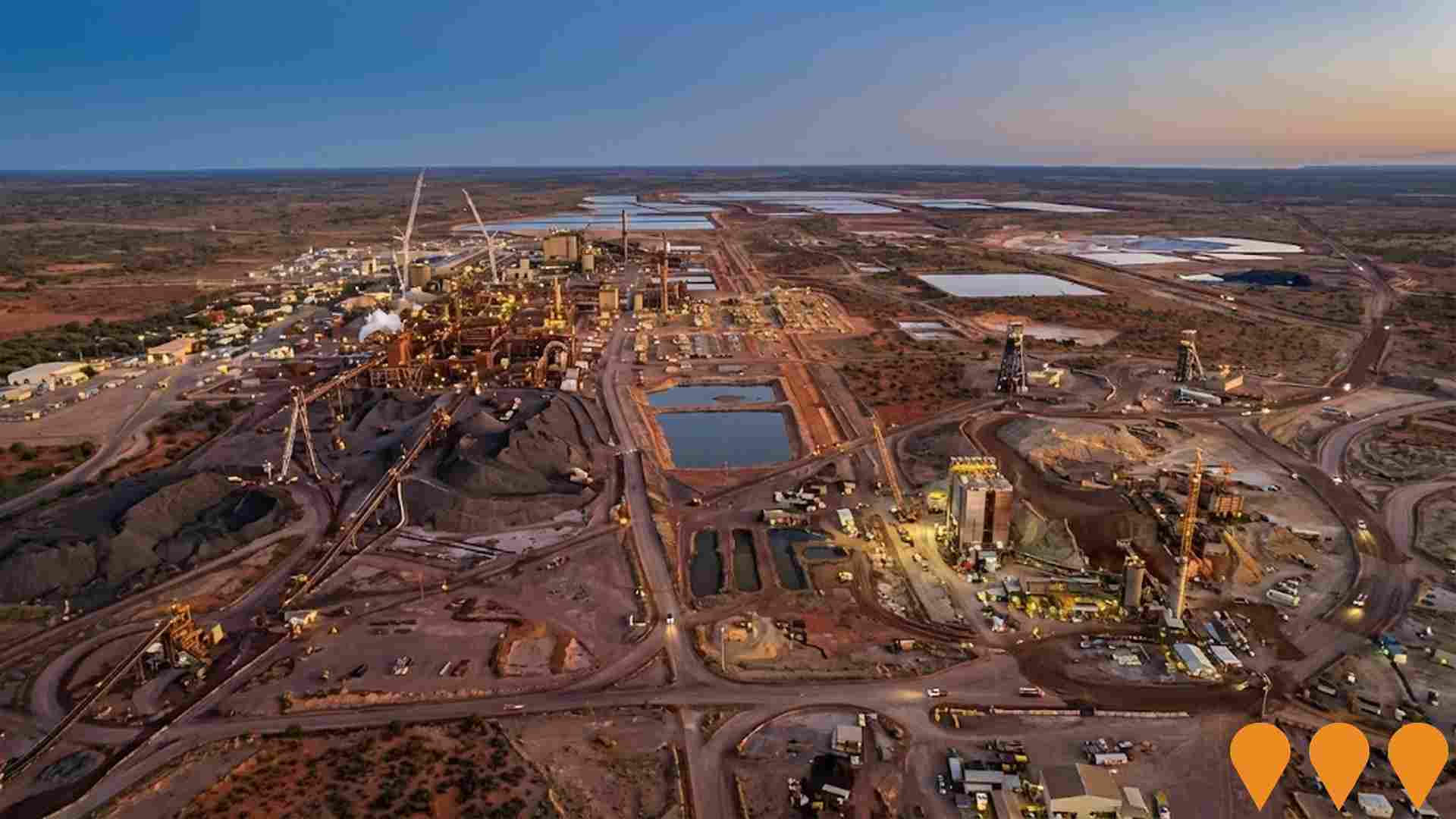
Bunnings Warehouse Port Augusta
The new Bunnings store in Port Augusta has officially opened, featuring a 5000 square meter space with a nursery, landscaping area, two-lane trade drive-through timber yard, and an outdoor living and barbecue area. The store was staffed almost entirely by Spencer Gulf locals.
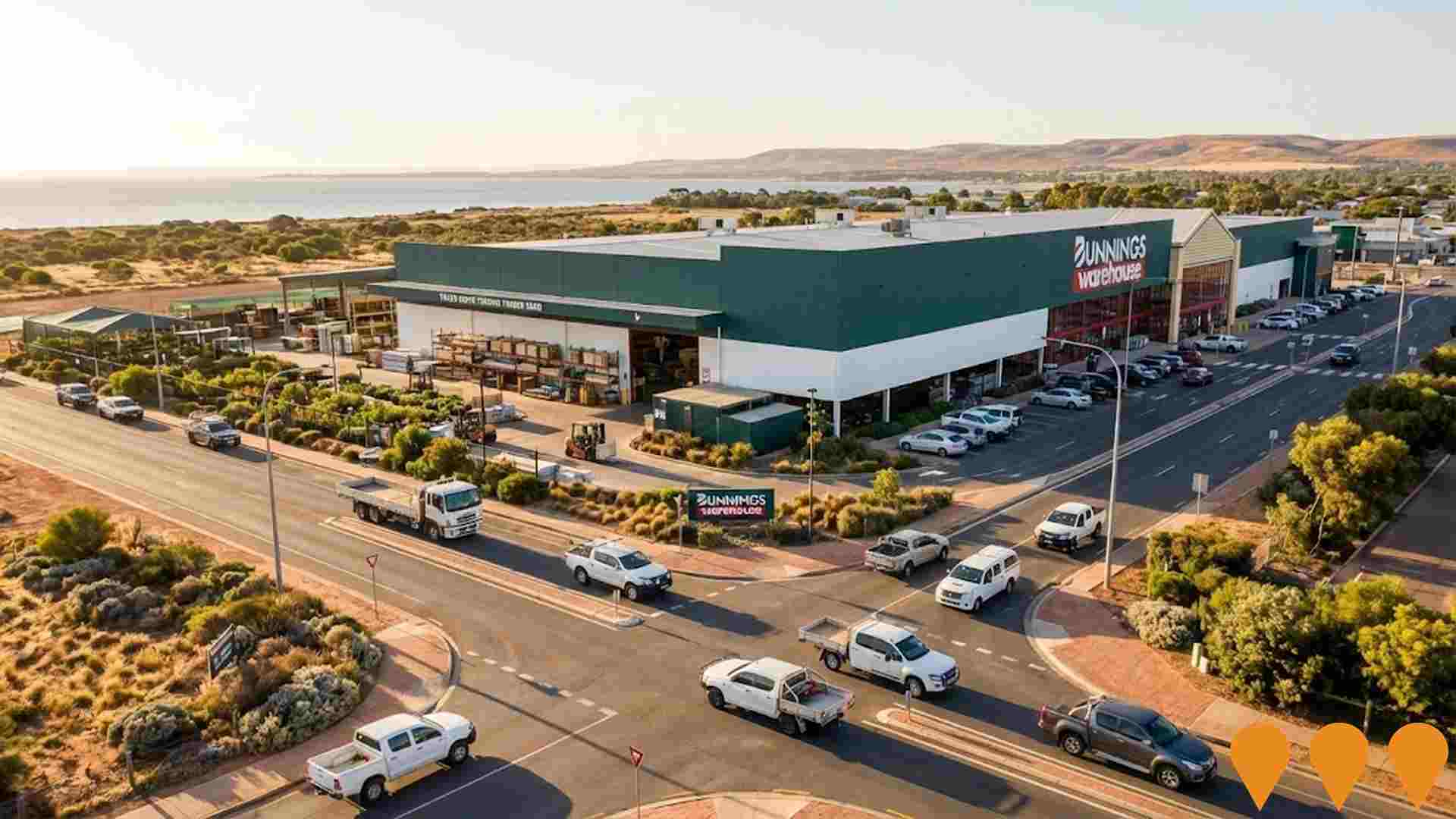
Oak Dam Underground Access Project
Advanced exploration project to establish underground access via twin declines to the deep iron oxide copper-gold (IOCG) mineralised system at Oak Dam, located on Kokatha country. The project is designed to enable efficient underground drilling for resource definition and geotechnical characterisation, supporting a potential future mining operation. Surface infrastructure includes utility facilities, diesel generation, a waste rock landform, and administration buildings. The total project life, including decline construction, exploration, and closure, is estimated at 10 years, with decline construction taking approximately 6 years.

Roxby Downs Area School Refurbishment
$7 million facility upgrade including refurbishment of four buildings with general learning areas, teacher preparation and breakout spaces, refreshed food technology areas, soundproofed music and drama studios, a new amphitheatre for open-air performances, broader landscaped outdoor learning areas, and a nature playground integrated with the desert landscape. The project reached completion in December 2021 and was officially opened in June 2024.

St Eyre Estate
A residential estate development located in Port Augusta West, with infrastructure for Stages 4 & 5A already in place, including roads, curbing, power, and water. These stages are available as a whole parcel to be subdivided into 60 spacious allotments, each approximately 1200 square meters. The vacant allotments allow for custom home builds, and the development is set against the scenic Baxter Ranges, with proximity to the Flinders Ranges and Spencer Gulf.

McKinnon Court Residential Development
This is a 3,100 square meter residential land lot in Port Augusta West, South Australia, that is available for sale. It is being marketed as an ideal location to build a dream home, a few courtyard homes, or to subdivide into smaller allotments, subject to council consent. The property is located next to a playground.

Cleary Street Residential Subdivision
A prime development opportunity in Port Augusta West, the 1.4 hectare site is zoned R-Residential and has a preliminary development plan to be subdivided into 18 allotments, subject to council approval. The land is on the market for sale.

Employment
Employment performance in Outback has been below expectations when compared to most other areas nationally
Outback has a diverse workforce with both white and blue-collar jobs, prominent manufacturing and industrial sectors, an unemployment rate of 6.2%, and an employment growth rate of 2.7% over the past year. As of June 2025, there are 1,245 employed residents, with an unemployment rate at 1.6% above Rest of SA's rate of 4.6%.
The workforce participation rate is 62.2%, higher than Rest of SA's 54.1%. Dominant employment sectors include agriculture, forestry & fishing, mining, and accommodation & food. Agriculture, forestry & fishing has a particularly high concentration with employment levels at 2.3 times the regional average. Health care & social assistance has limited presence, with only 3.6% of jobs compared to the regional average of 13.9%.
There is one job for every resident in Outback, indicating it functions as an employment hub attracting workers from surrounding areas. Between June 2024 and June 2025, employment increased by 2.7%, while labour force grew by 4.9%, leading to a rise in unemployment rate of 2.0 percentage points. In contrast, Rest of SA saw employment fall by 1.2% with minimal labour force expansion and a similar increase in unemployment rate. National employment forecasts from Jobs and Skills Australia, published in May 2025, project national growth rates of 6.6% over five years and 13.7% over ten years. Applying these projections to Outback's employment mix suggests local growth of approximately 4.2% over five years and 10.0% over ten years.
Frequently Asked Questions - Employment
Income
The area's income levels rank in the lower 15% nationally based on AreaSearch comparative data
AreaSearch's latest postcode level ATO data for financial year 2022 shows Outback's median income among taxpayers is $45,330. The average income is $53,859. This is lower than the national average. Rest of SA has a median income of $46,889 and an average of $56,582. Based on Wage Price Index growth since financial year 2022, current estimates for Outback's median income are approximately $51,146 by September 2025, with the average being around $60,769. According to 2021 Census figures, household incomes in Outback rank at the 14th percentile, while personal income ranks at the 65th percentile. The predominant income cohort spans 30.7% of locals, with incomes between $1,500 and 2,999. This mirrors the regional distribution where 27.5% fall into this bracket. Housing costs are modest, with 95.4% of income retained after housing expenses. However, total disposable income ranks at just the 27th percentile nationally.
Frequently Asked Questions - Income
Housing
Outback is characterized by a predominantly suburban housing profile, with above-average rates of outright home ownership
The dwelling structure in Outback, as per the latest Census, consisted of 89.5% houses and 10.6% other dwellings (semi-detached, apartments, 'other' dwellings). In comparison, Non-Metro SA had 85.7% houses and 14.3% other dwellings. Home ownership in Outback stood at 48.0%, with mortgaged dwellings at 10.8% and rented ones at 41.2%. The median monthly mortgage repayment was $659, significantly lower than Non-Metro SA's average of $1,138. The median weekly rent figure in Outback was recorded at $95, substantially below Non-Metro SA's $187 and the national average of $375. Nationally, Outback's mortgage repayments were significantly lower than the Australian average of $1,863.
Frequently Asked Questions - Housing
Household Composition
Outback features high concentrations of lone person households, with a lower-than-average median household size
Family households account for 49.1% of all households, including 17.0% couples with children, 25.3% couples without children, and 6.6% single parent families. Non-family households constitute the remaining 50.9%, with lone person households at 46.8% and group households comprising 3.7%. The median household size is 2.0 people, which is smaller than the Rest of SA average of 2.4.
Frequently Asked Questions - Households
Local Schools & Education
Outback faces educational challenges, with performance metrics placing it in the bottom quartile of areas assessed nationally
The area's university qualification rate is 12.9%, significantly lower than the Australian average of 30.4%. Bachelor degrees are most common at 9.9%, followed by postgraduate qualifications (1.7%) and graduate diplomas (1.3%). Vocational credentials are prevalent, with 47.7% of residents aged 15+ holding them - advanced diplomas account for 11.0% and certificates for 36.7%. Educational participation is high at 27.9%, including 14.3% in primary, 5.1% in secondary, and 2.1% in tertiary education.
Six schools operate within the area, educating approximately 116 students. The school network includes two primary and four K-12 schools. Local school capacity is limited at 5.8 places per 100 residents compared to the regional average of 15.4, leading many families to travel for schooling.
Frequently Asked Questions - Education
Schools Detail
Nearby Services & Amenities
Transport
No public transport data available for this catchment area.
Frequently Asked Questions - Transport
Transport Stops Detail
Health
Outback's residents are relatively healthy in comparison to broader Australia with a fairly standard level of common health conditions seen across both young and old age cohorts
Outback's health metrics closely match national benchmarks with common health conditions seen across both young and old age cohorts. The rate of private health cover is very low at approximately 47% of the total population (~940 people), compared to 53.1% across Rest of SA, which is lower than the national average of 55.3%. The most common medical conditions are arthritis and asthma, impacting 8.4 and 8.0% of residents respectively.
A total of 69.9% of residents declare themselves completely clear of medical ailments, compared to 68.2% across Rest of SA. Outback has 18.4% of residents aged 65 and over (369 people), which is higher than the 16.3% in Rest of SA. Health outcomes among seniors are above average, performing even better than the general population in health metrics.
Frequently Asked Questions - Health
Cultural Diversity
Outback ranks below the Australian average when compared to other local markets across a number of language and cultural background related metrics
Outback's cultural diversity was found to be below average, with 79.8% of its population being citizens, 87.8% born in Australia, and 89.7% speaking English only at home. Christianity was the predominant religion, making up 40.3% of Outback's population. However, the category 'Other' showed an overrepresentation, comprising 1.9% compared to the Rest of SA's 1.9%.
In terms of ancestry, Australian was the top group with 28.5%, followed by English at 26.8%, and Australian Aboriginal at 12.3%. Notably, Hungarian (0.6%), German (5.2%), and Scottish (8.3%) groups were overrepresented compared to regional averages of 0.2%, 4.8%, and 5.5% respectively.
Frequently Asked Questions - Diversity
Age
Outback hosts an older demographic, ranking in the top quartile nationwide
Outback's median age is 43 years, which is significantly below the Rest of SA average of 47 but substantially exceeds the national average of 38 years. The age profile shows that individuals aged 25-34 are particularly prominent, comprising 17.9% of the population, while those aged 75-84 are comparatively smaller at 4.8%. From 2021 to present, the percentage of individuals aged 65-74 has grown from 10.6% to 12.9%, and the 25-34 cohort has increased from 16.2% to 17.9%. Conversely, the 15-24 age group has declined from 11.9% to 8.4%, and the 45-54 group has dropped from 15.4% to 13.4%. By 2041, Outback is expected to see notable shifts in its age composition. The 75-84 age group is projected to grow by 62%, reaching 156 individuals from a previous count of 96. This growth is largely driven by the aging population dynamic, with those aged 65 and above comprising 95% of the projected growth. Conversely, population declines are projected for the 25-34 and 35-44 age cohorts.

